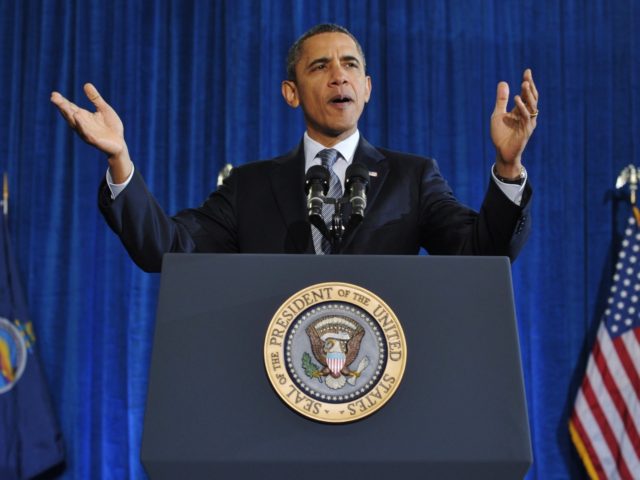Left-wing pundits have accused President Donald Trump of using his tweets last weekend to launch a divisive re-election campaign.
David Axelrod, former adviser to President Barack Obama, tweeted: “With his deliberate, racist outburst, @realDonaldTrump wants to raise the profile of his targets, drive Dems to defend them and make them emblematic of the entire party. It’s a cold, hard strategy.”
That is debatable — but if so, Axelrod should know; Obama did it first.
By 2011, Obama knew that re-election would be difficult. The Tea Party had just led the Republicans to a historic victory in the 2010 midterm elections, winning the House and nearly taking the Senate. The economy was only growing sluggishly, and Obama’s stimulus had failed to keep unemployment below eight percent, as projected. Moreover, the passage of Obamacare had provoked a backlash against Obama’s state-centered model of American society.
Facing a similar situation in the mid-1990s, President Bill Clinton had “triangulated,” moving back toward the middle, frustrating the GOP by taking up their issues, such as welfare reform.
But Obama rejected that approach. Having watched his icon, Chicago mayor Harold Washington, settle for an incremental approach when faced with opposition in the 1980s, only to die of a sudden heart attack before fulfilling his potential, Obama chose the path of hard-left policy — and divide-and-rule politics.
The first hint of his strategy emerged during the debt ceiling negotiations in the summer of August 2011. As Bob Woodward recounted in his book about the crisis, The Price of Politics, then-Speaker of the House John Boehner (R-OH) had wanted to reach a “grand bargain” with the president on long-term spending cuts. But Obama blew up that agreement by demanding $400 billion in new taxes, to his aides’ surprise. Obama wanted an opponent, not a deal. (Last week, Boehner told Breitbart News Tonight that Obama’s decision was his worst disappointment in 35 years of politics.)
In the fall of 2011, a new left-wing movement, Occupy Wall Street, was launched. A mix of communists, anarchists, and digital pranksters, the Occupy movement cast American society as a struggle between the “99 percent” and the “one percent.”
Obama and then-House Minority Leader Nancy Pelosi (D-CA) embraced the movement — and failed to distance themselves from it even as it collapsed into violence, sexual assault, and confrontations with police.
Instead, Obama picked up on Occupy’s themes and used them to shape his campaign.
In December 2011, Obama gave a speech at Osawatomie, Kansas — a place steeped in radical symbolism — at which he doubled down on his left-wing policies. He focused on the issue of economic inequality, and attacked the idea that the free market could lift the middle class to prosperity. “This isn’t about class warfare. This is about the nation’s welfare,” he insisted.
Then, in the spring of 2012, Obama made a controversial play on race. When a black teen, Trayvon Martin, was killed in Florida during a scuffle with neighborhood watch volunteer George Zimmerman, Al Sharprton — who was serving as an informal adviser to Obama at the time — made the local crime story into a national racial controversy. Obama, following Sharpton’s lead, weighed in: “If I had a son, he’d look like Trayvon,” Obama said at the time.
Poll numbers suggest that race relations, which had been improving, dropped precipitously after that. But to Obama, it was worth it: the campaign needed to find a way to motivate minority voters. (Vice President Joe Biden did his part, telling black voters that GOP nominee Mitt Romney was “gonna put y’all in chains.”)
Trump is pushing a non-racial, nationalist message. But if he actually wanted to divide America for political gain, he could learn from the master.
Joel B. Pollak is Senior Editor-at-Large at Breitbart News. He earned an A.B. in Social Studies and Environmental Science and Public Policy from Harvard. He is a winner of the 2018 Robert Novak Journalism Alumni Fellowship. He is also the co-author of How Trump Won: The Inside Story of a Revolution, which is available from Regnery. Follow him on Twitter at @joelpollak.

COMMENTS
Please let us know if you're having issues with commenting.